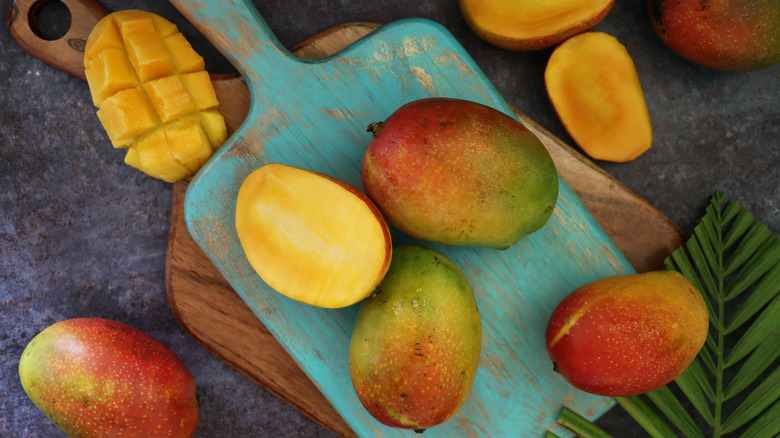Where To Store Mangoes To Keep Them From Getting Slimy
Mangoes are always a great addition in the kitchen, whether enjoyed on their own, in a cocktail, or in a summer salad — but it's important to store mangoes the right way so that they're juicy instead of slimy. Let's face it: no one wants to bite into a mango that's oozing slime. Keeping mangoes at room temperature is usually recommended if they're still unripe. If they're left out on the kitchen counter for too long, however, they could end up becoming slimy as a result of being overripe.
Luckily, there are ways to store mangoes to prevent them from turning bad. The easiest one is to store them in the fridge if they've ripened but aren't quite ready to eat (or add to a delicious curry). Storing ripe mangoes in the fridge will not only keep the mangoes fresh but make them easier to cut into slices or cubes for cooking.
As executive chef Shamil Velazquez tells Food & Wine, "Mangoes, similar to okra, tend to have mucilage or 'slime' when they fall from the tree. Placing them in the fridge prevents some of that mucilage from forming."
Tips for storing mangoes in the refrigerator
Storing mangoes in the fridge slows the ripening process, so they don't turn into a slime fest. That said, there are some essential tips to follow when storing mangoes in the fridge so they don't become mushy. Mangoes should be kept in the fridge's crisper drawer instead of in an airtight container. This is because, unlike some other fruits, mangoes are sensitive to ethylene gas that can speed up their ripening process. By ensuring that this gas can escape, the mangoes won't spoil. Once stored in the fridge, mangoes last about five days, so using them within that time frame is essential for the best results.
But remember — only refrigerate mangoes when they're ripe. Common characteristics of a ripe mango include color changes, where the fruit moves from green to red or orange; a bit of give in the flesh when the mango is pressed; and a sweet scent.
Can you eat slimy mangoes?
Slimy, overripe mangoes, although not ideal, don't have to be tossed into the compost bin. They can be a great way to be a bit more creative in the kitchen — you can add them to smoothies or use them to make a sweet puree. However, storing slimy mangoes isn't recommended — it won't be long before they become unappetizing and unusable.
Although slimy mangoes can be used in recipes, there are times when sliminess is a sign that a mango is going rotten and therefore shouldn't be consumed. If there's just a bit of slime or juiciness but the mango has a sour smell, that indicates the mango is starting to go bad. Other signs include bruised or moldy patches on the mango skin. A mango should never feel too soft when pressed. Note that if there are slimy cuts on the mango's skin, this can let bacteria enter the fruit, which can be a health hazard, so it's best to throw the mango out.


